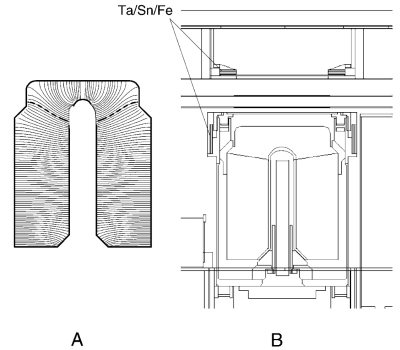X-ray and gamma-ray spectroscopy
| Nugget | |
|---|---|
| Number: | 27 |
| 1st Author: | Hugh Hudson |
| 2nd Author: | David Smith |
| Published: | 22 January 2006 |
| Next Nugget: | One small step for a photon... |
| Previous Nugget: | Sunquakes: Seismic Transients from Solar Flares |
Introducing one of RHESSI's main purposes
Reuven Ramaty, whose name adorns our satellite, specialized in astronomical gamma-ray spectroscopy. A reader may wonder how a photon so energetic as to penetrate inches of lead shielding can ever be tamed spectroscopically. RHESSI does this better than any previous astronomical instrument, and this nugget introduces the subject. RHESSI both images and makes high-resolution spectra simultaneously ("imaging spectroscopy"), but most of our previous nuggets have emphasized the imaging. We hope to have several future nuggets on some of the many observational results of the RHESSI spectroscopic capability.
Germanium detectors
The key to RHESSI's spectroscopic success lies in the properties of "hyperpure" germanium, which has the property of converting energy deposition precisely and linearly into electric charge, which can then be amplified and processed. Such a counter has a prototype in the "proportional counter", which introduced to physics the idea of "non-dispersive spectroscopy," in which one measures the energy of individual photons rather than using prisms or gratings to sort the energies. Non-dispersive spectroscopy, although usually of lower resolution, has the multiplex advantage, meaning that RHESSI can measure all photons of any energy at all times; no spectral scanning is required.
So how do germanium (Ge) solid state detectors work? RHESSI carries nine large hyperpure Ge crystal detectors. When a photon deposits its energy within the detector, electron-hole pairs (charges) are produced. To sweep up these charges, one needs a strong electric field. The figure below shows the pattern of electric field lines resulting from the high voltage (-4000 V) applied to the outer surface of the detector:

Photon Energy
The main reason to use germanium -- an expensive detector material that must be operated below 100K -- is its superb energy resolution. Photon energy can be measured to within about 1 keV for hard X-rays in the front segments (below about 200 keV) and to within about 2 to 5 keV in the rear segments. For an MeV photon, this is a very high accuracy! It not only allows solar gamma-ray lines to be identified with specific nuclear processes, it even allows their Doppler profiles to be studied, in analogy to optical spectroscopy. Figure 2 shows an intrinsically narrow solar gamma-ray line from RHESSI's first gamma-ray line flare.

Figure 3a. A visual representation of the response matrix for the front detectors (left) and rear detectors (right). Note the energy range difference in the axes, since the fronts detect low energies (X-rays) while the rears detect the high energies (gamma-rays). The color display is logarithmic. Click for an image for a larger version.
The non-diagonal response is quite complex and includes many different processes, though most of the response at low energies is actually in the "diagonal elements" of the matrix, the thin yellow line. Above a few hundred keV, the off-diagonal response makes up the majority of the counts.
Here are these plots again with specific features marked.
Figure 3b. Same as figure 3a but with non-diagonal features marked. Click an image for a larger version.
In cases where the full energy is not collected, the incoming photon does one of the following:
- Compton-scatters off of an electron and exits the detector leaving only a fraction of its energy. This accounts for most of the off-diagonal activity and the strong Compton edge.
- Compton-scatters through a small angle in the grids (or anything else) and into the detector.
- Compton-scatters through a large angle (backscatters) into the detector.
- excites K-shell fluorescence peaks from nearby passive material, including the tungsten collimator grids (59 keV, 67 keV).
- generates a germanium K-shell (~ 10 keV) fluorescence photon which escapes.
- generates an electron and positron pair outside of the detectors; the positron subsequently annihilates on another electron, generating the line at 511 keV.
- generates an electron and positron pair inside of the detector, with one or two of these annihilation photons escaping, giving two spectroscopic escape peaks.
Remarks
The purpose of this RHESSI science nugget was just to introduce some of the ideas behind X-ray and gamma-ray spectroscopy, which is a somewhat obscure subject in astrophysics because of its extraordinary difficulty. In spite of this difficulty, the off-diagonal effects can be rather well accounted for by a combination of simulations and laboratory measurements. Removing the effects of the off-diagonal response is part of the RHESSI software. Future science nuggets will discuss some of the observations made with this system.
Biographical note: Hugh Hudson is at UC Berkeley, and David Smith is at UC Santa Cruz. We thank Richard Schwartz and Albert Shih for the lovely images of the response matrices.
RHESSI
education